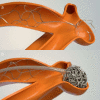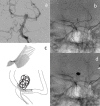Comprehensive review of the recent advances in devices for endovascular treatment of complex brain aneurysms
- PMID: 34609898
- PMCID: PMC8722252
- DOI: 10.1259/bjr.20210538
Comprehensive review of the recent advances in devices for endovascular treatment of complex brain aneurysms
Abstract
The International Subarachnoid Aneurysm Trial (ISAT) showed superiority for endovascular treatment of ruptured aneurysms and technology has since moved on rapidly. Many approaches and technology now exist for the endovascular management of ruptured and unruptured intracranial aneurysms, which reflects their varied nature - there is no one-size-fits-all technique. We aim to provide an overview of the various classes of device and the major developments over the past decade. Coiling is the oldest of the technology and continues to demonstrate high levels of occlusion and acceptable risks, making it the default treatment choice, particularly in the acutely ruptured aneurysm setting. Advances on coiling include the use of adjuncts such as balloons, stents and fully retrievable temporary neck-bridging devices, which have facilitated the treatment of more complex aneurysms. Flow divertors have also revolutionised complex aneurysm treatment with small added risk in acute aneurysm treatment and seek to remodel the aneurysm-vessel interface without accessing the aneurysm sac. The latest development and most promising avenue appears to be intrasaccular flow disrupting devices like WEB, Contour and Neqstent that provide excellent opportunities to treat wide neck complex aneurysm with minimal mortality and morbidity and good occlusion rates and may in future replace a significant number of stent-assisted coiling too.
Figures














Similar articles
-
Comparison of Low-Profiled Visualized Intraluminal Support Stent-Assisted Coiling and Coiling Only for Acutely Ruptured Intracranial Aneurysms: Safety and Efficacy Based on a Propensity Score-Matched Cohort Study.Neurosurgery. 2020 Sep 1;87(3):584-591. doi: 10.1093/neuros/nyaa110. Neurosurgery. 2020. PMID: 32415845
-
Nautilus-Assisted Coiling of an Unruptured Wide-Necked Aneurysm of the Posterior Communicating Artery.World Neurosurg. 2021 Jul;151:117. doi: 10.1016/j.wneu.2021.04.139. Epub 2021 May 12. World Neurosurg. 2021. PMID: 33989820
-
WEB-only treatment of ruptured and unruptured intracranial aneurysms: a retrospective analysis of 47 aneurysms.Acta Neurochir (Wien). 2019 Aug;161(8):1507-1513. doi: 10.1007/s00701-019-03988-0. Epub 2019 Jun 25. Acta Neurochir (Wien). 2019. PMID: 31240584
-
Acutely Ruptured Intracranial Aneurysms Treated with Flow-Diverter Stents: A Systematic Review and Meta-Analysis.AJNR Am J Neuroradiol. 2018 Sep;39(9):1669-1675. doi: 10.3174/ajnr.A5730. Epub 2018 Jul 26. AJNR Am J Neuroradiol. 2018. PMID: 30049721 Free PMC article.
-
Endovascular techniques for the management of wide-neck intracranial bifurcation aneurysms: A critical review of the literature.J Neuroradiol. 2016 Jun;43(3):167-75. doi: 10.1016/j.neurad.2016.02.001. Epub 2016 Mar 11. J Neuroradiol. 2016. PMID: 26976346 Review.
Cited by
-
Endovascular treatment of middle cerebral artery aneurysms: current status and future prospects.Front Neurol. 2023 Nov 15;14:1239199. doi: 10.3389/fneur.2023.1239199. eCollection 2023. Front Neurol. 2023. PMID: 38033773 Free PMC article. Review.
-
Addressing Challenges in Cerebral Aneurysm Management: Strategies to Enhance Patient Outcomes.J Clin Med. 2024 Apr 16;13(8):2308. doi: 10.3390/jcm13082308. J Clin Med. 2024. PMID: 38673580 Free PMC article.
-
pCONUS 2 and pCONUS 2-HPC in the treatment of wide-necked intracranial aneurysms: Multicentre UK experience.Interv Neuroradiol. 2025 Feb;31(1):63-70. doi: 10.1177/15910199221150467. Epub 2023 Jan 8. Interv Neuroradiol. 2025. PMID: 36617807 Free PMC article.
-
Endovascular treatment of intracranial internal carotid artery bifurcation region aneurysms.Front Neurol. 2024 Mar 28;15:1344388. doi: 10.3389/fneur.2024.1344388. eCollection 2024. Front Neurol. 2024. PMID: 38606281 Free PMC article. Review.
-
Current status and prospects of endovascular treatment for intracranial vertebral artery aneurysms: A narrative review.Medicine (Baltimore). 2025 Apr 25;104(17):e42265. doi: 10.1097/MD.0000000000042265. Medicine (Baltimore). 2025. PMID: 40295275 Free PMC article. Review.
References
-
- Molyneux AJ, Kerr RSC, Yu L-M, Clarke M, Sneade M, Yarnold JA, et al. . International subarachnoid aneurysm trial (ISAT) of neurosurgical clipping versus endovascular coiling in 2143 patients with ruptured intracranial aneurysms: a randomised comparison of effects on survival, dependency, seizures, rebleeding, subgroups, and aneurysm occlusion. Lancet 2005; 366: 809–17. doi: 10.1016/S0140-6736(05)67214-5 - DOI - PubMed
-
- Pierot L, Barbe C, Herbreteau D, Gauvrit J-Y, Januel A-C, Bala F, et al. . Rebleeding and bleeding in the year following intracranial aneurysm coiling: analysis of a large prospective multicenter cohort of 1140 patients-Analysis of recanalization after endovascular treatment of intracranial aneurysm (ARETA) study. J Neurointerv Surg 2020; 12: 1219–25. doi: 10.1136/neurintsurg-2020-015971 - DOI - PubMed
Publication types
MeSH terms
LinkOut - more resources
Full Text Sources
Other Literature Sources
Medical
Miscellaneous

